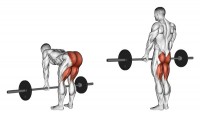Romanian Deadlift Variants for Hamstring Flexibility and Strength
According to weightlifting lore, the Romanian deadlift was named when American powerlifters spotted Nicu Vlad, a champion Romanian weightlifter, performing the exercise prior to winning an Olympic medal. The movement deals primarily with hip extension, and is one of the best known and most effective exercises for the hamstrings and glutes, increasing strength and flexibility. Because it trains the posterior chain, the Romanian deadlift is an indispensable exercise for many types of athletes, particularly any athletes whose sports involve running or generating power with the hips and legs.
Romanian Deadlifts are Exceptional for Developing the Hamstrings
Anytime hamstring exercises come up, most people think of the leg curl machine at the gym. Not only is this a dangerous exercise because of the shearing forces it places on the knee ligaments, but it is also a terribly ineffective movement for strengthening the hamstrings. Of the major hamstring muscles, semitendinosus, semimembranosus, and the long head of the biceps femoris cross the hip joint, making them hip extensors. This leaves only the short head of the biceps femoris muscle as an exclusive knee flexor, explaining why a hip extension exercise like the Romanian deadlift involves the hamstrings.
The Romanian deadlift does more than just involve the hamstrings, though. Because the glutes contribute more power during hyperextension than extension, the hamstrings are the primary movers in the extension-exclusive Romanian deadlift. In addition, the bottom position of the exercise produces a fantastic stretch in the hamstrings, resulting in increased flexibility on top of the strength gains.
One-legged Romanian Deadlifts
The one-legged variation of this exercise introduces an additional dimension of balance, further challenging the core and numerous stabilizing muscles. To perform the exercise, start by standing in a neutral position, feet hip width apart, spine in neutral, and face forward. Lift one foot from the ground by flexing slightly at the hip and knee. With a braced core, shoulders retracted, and a small arch in the lower back, push the hips back to reach for the ground. A slight bend in the knees during the descent is acceptable, particularly for those with limited hamstring flexibility. Return to an upright position by extending at the hips and knees, remembering to activate the glutes to assist the hip extension and support the lower back. After some practice, try loading the exercise with a barbell or dumbbells, which will both increase the level of difficulty and provide a greater stretch at the bottom of the movement.
Benefits of Romanian Deadlifts
The Romanian deadlift and its many variations provide a massive number of health and performance benefits. Powerlifters stand to gain a great deal from a novel lift that effectively challenges the posterior chain. Any athletes whose sports involve running or sprinting should incorporate the Romanian deadlift into their fitness routines, as the nature of the lift’s extension action translates almost perfectly to the pawback motion of running. The eventual increase in hamstring flexibility is also of note, since better flexibility of these muscles signifies a statistical decrease in many types of athletic injury risks. Reducing tightness and increasing strength in the hamstrings and glutes can also prevent and, in some cases, eliminate lower back pain. Regardless of who uses this outstanding compound movement, the Romanian deadlift can confer considerable benefits in numerous areas of fitness.
23936 total views, 2 today






